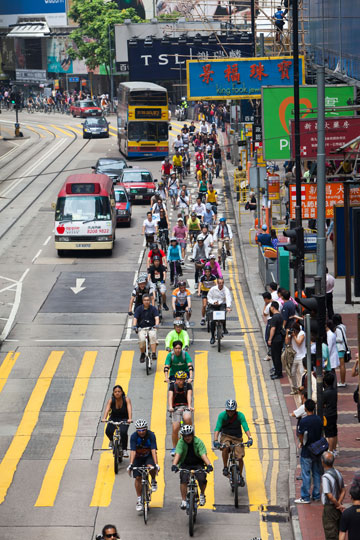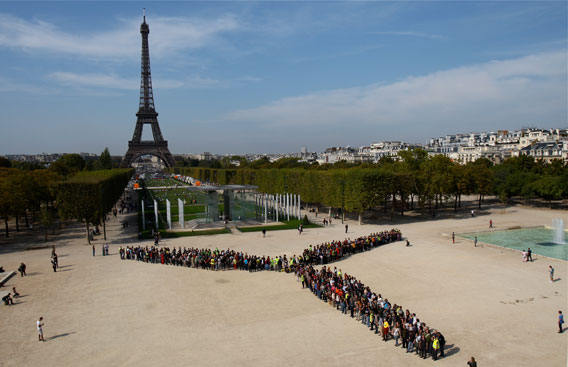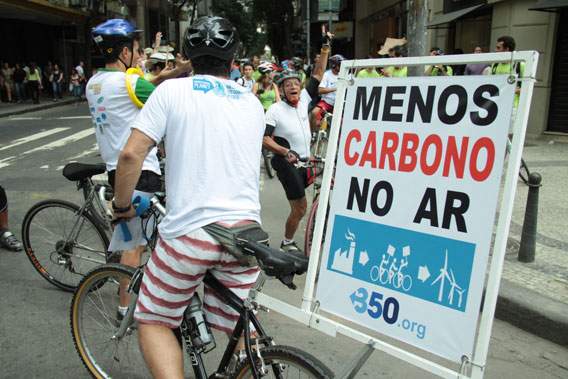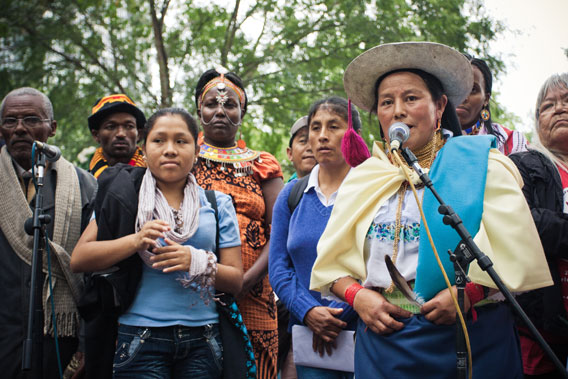
Young people rally in Kiev, Ukraine at apart of the Moving Planet campaign. Photo by: Maxm Gorpenyuk.
On six continents, in over 75 percent of the world’s countries, people came out en masse yesterday to attend over 2,000 events to demonstrate the power of renewable energy to combat global climate change. As apart of the ‘Moving Planet’ campaign organized by 350.org, activists created a giant human-windmill in Paris, gave out bike lessons in Buenos Aires, practiced evacuation measure in the Pacific island of Tuvalu imperiled by rising sea levels, and marched in Cape Town for a strong agreement at the next UN climate meeting hosted in Durban, South Africa.
“The planet has been stuck for too long with governments doing nothing about the biggest problem we’ve ever faced,” said Bill McKibben, founder of 350.org. “This is the day when people will get the earth moving, rolling towards the solutions we need.”
Many events took on a local flavor. In Sydney activists flew kites calling for the government to put a price on carbon, an issue that the current Australian administration supports but has seen fierce opposition. In the US many activists spoke out against the Keystone XL pipeline that would bring tar sands oil down from Canada to Texas; oil from the tar sands releases significantly more carbon than more conventional sources. In India, ten thousand citizens protested the proposed construction of 80 new coal fired power plants. However, all the events were pushing for societal rejection of fossil fuel power with aggressive pursuit toward renewable and clean energy.
 Bikes far outnumber cars in bike parade in Hong Kong. Photo by: Jason Findley. |
Many people biked, rollerbladed, skate boarded, and took public transit to events. In Santo Domingo, activists painted the Dominican Republic’s first bike lane.
Scientists have warned for decades that the reliance of global society on fossil fuel energy is putting greenhouse gases into the atmosphere and warming the Earth. 350.org takes its moniker from the scientific-assertion that carbon should be below 350 parts per million in order to retain a stable climate; currently carbon is 390 parts per million.
“Moving Planet, is a global expression of unity, urgency and purpose to show political and business leaders they need to move from rhetoric to action,” said Kumi Naidoo, executive director of Greenpeace International, in a press release. “Today, we’re beginning to move in the right direction.”
Naidoo, who was recently arrested off Greenland for boarding an oil rig in the Arctic as apart of an act of civil disobedience, joined hundreds of people protesting a new coal plant in Chicago.
Global climate change is expected to cause, and in many cases has already been linked to, melting of the Arctic, global sea level rise, increased droughts and floods, worsening extreme weather, mass extinction, desertification, amid other impacts such as increased global conflict and famine. Given that governments worldwide have not yet adequately addressed climate change, the ‘Moving Planet’ day was developed as a chance for citizens to show that fighting climate change is feasible.
“Speak against climate change, talk to your families, community members, your elders and your government,” Krishneil Narayan, Pacific media engagement director with 350.org, told the Fiji Times. “You are neither wrong nor alone to ask for a better planet to live in.” A thousand trees were planted in Fiji among other events.
Across the Pacific Ocean in San Francisco, thousands marched and biked down Market Street. Mother and daughter, Jennifer and Harper Harris, were among the marchers.
“Having her made me realize even more how we need to take action now—it makes this more personal,” Jennifer Harris told the San Francisco Gate. “And I want her to understand that in a democracy, part of our responsibility is to show up and say what we want from our government.”
The global day of action opened in the Pacific Island of Tonga at sunrise where a village priest prayed for climate change mitigation, followed by a village choir singing.

People create the image of a turbine backed by the Eiffel Tower in Paris. Photo by: Nicolas Chauveau.

Cyclists in Rio de Janeiro taking action. Photo by: Victor Motta.

Speakers at a rally in New York City. Photo by: Josh Lopez.
Related articles
Gore launches 24-hr push to ‘confront the reality’ of climate change
(09/14/2011) For the next 24 hours the Climate Reality Project — an initiative founded and chaired by former Vice President Al Gore — is hosting an event to mobilize action on climate change. The entire event will be broadcast live and presented in 13 languages.
Northwest Passage open as sea ice falls to lowest cover ever recorded
(09/12/2011) Arctic sea ice cover fell to its lowest level on record, report researchers from the University of Bremen.
Climate test for Obama: 1,252 people arrested over notorious oil pipeline

(09/06/2011) Two weeks of climate disobedience at the White House ended over the weekend with 1,252 people arrested in total. Activists were protesting the controversial Keystone XL pipeline in an effort to pressure US President Barack Obama to turn down the project. If built the pipeline would bring oil from Alberta’s tar sands through six US states down to Texas refineries. While protestors fear pollution from potential spills, especially in the Ogallala Aquifer which supplies water to millions, the major fight behind the pipeline is climate change: Canada’s tar sands emit significantly more carbon than conventional sources of oil.